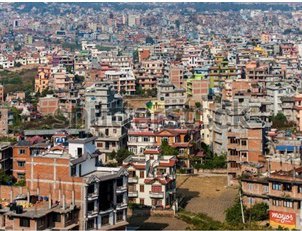
Nepal is one of the least urbanized but the fastest urbanizing countries in the world. Only 18.2% of people had lived as urbanites in 2014 while after restructuring of federal Nepal 66.17%, according to National Population Housing Census 2021, of people have been urbanites since 2017, at least, in theory. However, in practice, there are several contradictions in terms of, among many others, status of infrastructural development, availability of physical facilities, availability and accessibility to free or affordable quality health and education services, availability to clean water, environment including socio-economic activities within urban compared to urban, and less urban, to no urban areas. High urban haphazard growth has especially been occurring in mid-sized and large-sized cities of Nepal. Kathmandu, Pokhara, Lalitpur, Bhaktapur, Birgunj, Biratnagar, Butwal and Dharan are some of the dominant examples of haphazard urban growth although the haphazard development cannot be ruled out even in small and newly emerging cities as the new urban areas are also starting from conventional, haphazard and unplanned approaches.
Studies conducted in urbanization and even National Urban Development Strategies of 2017 note that urban development trend of Nepal suffers from many interlinked as well as fragmented challenges. Some of the key challenges are: a) the system and hierarchy of urban areas is unbalanced both in population and resource terms; b) the unplanned informal urban growth and urban sprawl is clearly getting manifested as unmanageable; c) wide deficits exist in basic urban infrastructure such as, inter alia, roads, water supply, sewerage and drainage, solid waste and e-waste management, energy, urban open space, basic physical amenities, and housing; d) urban environmental concerns are growing to critical levels due to air, land, noise pollution, urban transport issues, high fossil fuel consumption, land use incompatibility, public space encroachment and growth of squatter settlements, disregard for cultural heritage and aesthetics, and environmental risk mitigation and disaster resilience; e) there is no off-farm employment opportunities and there are no initiatives for urban employment generation and local economic development strategies; f) poverty is unbelievably rising in urban areas as rural-urban migration gathers momentum aggravating the problem of housing and infrastructure to cater the needs of the rapidly increasing population; g) urban governance and institutional frameworks are visionless and weak, and an increasing scarcity of skilled human resources with both dynamic leadership and long-term vision for urban planning and management; h) precarious urban finance and revenue base and there are wide gaps between urban investment needs, sources of financing and capability for implementation; i) there is a lack of coordination and cooperation between inter-government bodies and inter-departmental institutions; clearly coordinated efforts do not exist with vision and plan for national, regional, municipal development; j) there is paucity of urban data base and there is no monitoring of urban developments.
The existing infrastructural development, both physical and social, and cities' capacities to deliver public delivery services are highly limited. None of the cities of Nepal serve as a model of sustainable smart city, which can be taken for granted to establish a new city for urban expansion and settlement. The paper-based declaration of the government of Nepal about smart cities is also limited to having people mobile phone ONLY and it has nothing to do with sustainable smart city. Therefore, a billion dollar question is how do we establish sustainable smart cities? Adding to this question is what can we do to make the existing cities more sustainable and smart? Do we follow our conventional practice of making cities where we build from one house to many houses first without ensuring any urban facilities and access, then start making hallabulla for, both, physical hardware urban infrastructures and the rest connected with software related urban infrastructures. Often times, we build houses first and then start looking for road facilities, access to water, electricity, healthcare, education and employment opportunities. And we spend many years' time fixing all these and by that time, our roads are already small, and the land is already so expensive that no one wants to give a small piece of land for road expansion. Other infrastructural facilities also become poor and limited by that time. The only entities in abundance are people and houses. The second trending model of haphazard urbanization is plotting. In this approach, brokers buy a certain area of land and often make small plots of 3 aanas to 5 annas and these plots are kept on sale and sold. The plotters do not ensure road size, sewage system, environmental concerns and public spaces but with big advertisements and false brokering with conditions apply, sale the land and the buyers have to undergo several rounds of pains while building houses and afterwards for accessing to hardware infrastructural and software infrastructural services as that of conventional practice of urbanization. These are the two handicapped competing and trending approaches of urbanization in Nepal.
Furthermore, once the land is bought, in the small plots houses are built and all the areas are covered with cement to avoid touch from the soil in the name of avoiding dirt. However, this practice has created serious problem in terms of balance of biodiversity, environmental concerns and natural recharge process of water from rainfall. Consequently, ground water table are declining year by year in mega-cities and everywhere. House-owners are full of questions about why their water-wells do not have water any longer but they do not realize how they have themselves harmed the natural process of percolation of water for making groundwater sustainable. The garbage/waste produced from each household is beyond the management capacity of local governments. No cities of Nepal are made available with clean drinking water where people directly fill their glasses from tap and drink water feeling certain about their health and safety. Access to government health, education and other day to day services are disgusting. Public transport system is so poor that no one dares to feel comfortable and safe with the bus, microbus, and taxi services. Furthermore, none of the existing cities are self-reliant in terms of agricultural products. For example, if the road of Narayangath to Kathmandu is blocked for a week or so due to landslide or any other reasons, goods prices double or triple in Kathmandu. It has been experienced many times and particularly during the Indian blockade in 2015. Corruption is glued to all three tiers of government, therefore, unexpected and unwanted policies are introduced, terminated and reintroduced. For example, kittakaat of land, especially for plotting.
These all suggest that although Nepal is one of the fastest urbanizing countries in the world, the patterns of urbanization is haphazard and this practice must be stopped to literally bring the concept of sustainable smart cities into practice. The priority must be on sustainable fixing the challenges shown by literature and NUDS 2017 and for all these we now need to plan and design urban development differently. If we plan to build a new city, government must take full responsibility from land pooling to design of the city. The design must include at least next 50 to 100 years future scenario from the size of demography, urban services to all other urban requirements and the facilities. It must include, at minimum, the following components: residential area, recreational area, industrial area, agricultural area, the market and the smart people. These must be integral and contribute to each other for building sustainable smart cities. The new cities must also ensure all the facilities and accesses. A Nepali-value based visionary urban master plan/design is a must to capture historic Nepaliness, at least, in future cities of Nepal.
[chandra.pandey@ku.edu.np]
- 16thPeriodic Plan for Delivering Basic Services and Fundamental Rights?
- Feb 08, 2024
- Disaster Governance: Theory And Practice In Nepal
- Dec 05, 2023
- Say No To Pre-Election Coalition
- Jul 14, 2022
- Nepalis Are Optimistic:Findings Of SNP 2020
- Apr 12, 2021
- Corruption: Practices & Remedies
- Oct 02, 2020













